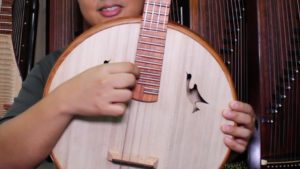
How to Tune Your Guzheng
May 6, 2019
Chinese Ensemble National Day Covers
August 15, 2019Mastering the Art of Tuning Zhongruan, Liuqin, and Pipa: A Comprehensive Guide
Welcome back to another enlightening “How-To” session! Today, we’re diving into the realm of tuning the Zhongruan, Liuqin, and Pipa—three captivating string instruments that captivate with their unique tones. Ever wondered how these instruments stay perfectly in tune or what pitches they’re tuned to? We’re here to unravel the mystery and provide you with all the essential tuning insights.
Tuning these instruments isn’t as daunting as it may seem. Similar to tuning the Guzheng, all you require are a chromatic tuner, picks/faux nails, and a basic understanding of standard tuning for each of these instruments.
Let’s begin by acquainting ourselves with the strings. When you hold the instrument, the string farthest to the right, which happens to be the thickest, is labelled the “4th string.” Moving leftwards, you’ll find the “3rd string,” “2nd string,” and finally, the “1st string.”
Now, let’s delve into the standard tuning for each instrument:
Zhongruan & Liuqin:
- Zhongruan: G2, D3, G3, D4
- Liuqin: G3, D4, G4, D5 (an octave higher than Zhongruan)
Pipa:
- Pipa: A2, D3, E3, A3
The numerical value behind the alphabet lets you know in what range (how low or how high) the notes are. Middle C is C4, so you can use that as a reference to know if you’re tuning too much or too little.
Understanding the peg placements and their corresponding strings is crucial. The Zhongruan has mechanical tuning pegs similar to a guitar, while the Liuqin and Pipa have different peg arrangements. We’ve included some images below to illustrate each instrument’s peg placement for your convenience.
When it comes to tuning, turning the pegs anti-clockwise tightens the strings, raising the note’s pitch. For a more detailed explanation of scales and the tuning process, you can refer to our Guzheng tuning video [here]!
Tuning the Zhongruan is relatively straightforward. Let’s move on to the Liuqin, which boasts a unique feature: four fine adjusters located at the instrument’s bottom end. These adjusters are crucial, especially considering the Liuqin strings are more delicate. Turning these fine adjusters down raises the pitch. Tuning the Liuqin (and Pipa) involves pushing the pegs while tuning, ensuring a more secure adjustment. You can watch our instructional video at the end of this post to observe this process.
The fine adjusters found only on the LiuqinOne handy tip for tuning these plucking instruments is that if you find your strings slightly too high, you can gently pull the strings to adjust. Yes, you read that right—pulling the strings can help fine-tune the pitch.
We’ve prepared the instructional video above detailing the tuning process for each instrument, so feel free to check it out for a more comprehensive understanding.
And there you have it! Enjoy the video and stay tuned for more informative content in our next video! If you have any further inquiries or need assistance with tuning Chinese instruments, don’t hesitate to reach out. Happy tuning!











2 Comments
That was very helpful. Thank you very much!
Thanks Crystal!